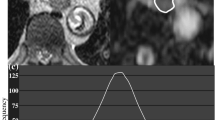Abstract
The purpose of this study was to assess the value of diffusion-weighted magnetic resonance imaging (DWI) in detecting esophageal cancer and assessing lymph-node status, compared with histopathological results. DWI was prospectively performed in 24 consecutive patients with esophageal cancer, using the diffusion-weighted whole-body imaging with background body signal suppression (DWIBS) sequence. DWIBS images were fused with T2-weighted images, and independently and blindly evaluated by three board-certified radiologists, regarding primary tumor detectability and lymph-node status. Apparent diffusion coefficients (ADCs) of the primary tumor and lymph nodes were also measured. Average primary tumor detection rate was 49.4%, average patient-based sensitivity and specificity for the detection of lymph-node metastasis were 77.8 and 55.6%, and average lymph-node group-based sensitivity and specificity were 39.4 and 92.6%. There were no interobserver differences among the three readers (P < 0.0001). Mean ADC of detected primary tumors was 1.26 ± 0.29×10−3 mm2/s. Mean ADC of metastatic lymph nodes (1.46 ± 0.35×10−3 mm2/s) was significantly higher (P < 0.0001) than that of nonmetastatic lymph nodes (1.15 ± 0.24 mm2/s), but ADCs of both groups overlapped. In conclusion, this study suggests that DWI only has a limited role in detecting esophageal cancer and nodal staging.






Similar content being viewed by others
References
Holmes RS, Vaughan TL (2007) Epidemiology and pathogenesis of esophageal cancer. Semin Radiat Oncol 17:2–9
Pera M, Manterola C, Vidal O, Grande L (2005) Epidemiology of esophageal adenocarcinoma. J Surg Oncol 92:151–159
DeMeester SR (2006) Adenocarcinoma of the esophagus and cardia: a review of the disease and its treatment. Ann Surg Oncol 13:12–30
Kelly S, Harris KM, Berry E et al (2001) A systematic review of the staging performance of endoscopic ultrasound in gastro-oesophageal carcinoma. Gut 49:534–539
Schröder W, Baldus SE, Mönig SP, Beckurts TK, Dienes HP, Hölscher AH (2002) Lymph node staging of esophageal squamous cell carcinoma in patients with and without neoadjuvant radiochemotherapy: histomorphologic analysis. World J Surg 26:584–587
Bruzzi JF, Munden RF, Truong MT et al (2007) PET/CT of esophageal cancer: its role in clinical management. Radiographics 27:1635–1652
Van Westreenen HL, Westerterp M, Bossuyt PM et al (2004) Systematic review of the staging performance of 18F-fluorodeoxyglucose positron emission tomography in esophageal cancer. J Clin Oncol 22:3805–3812
Hofstetter W, Correa AM, Bekele N et al (2007) Proposed modification of nodal status in AJCC esophageal cancer staging system. Ann Thorac Surg 84:365–373
Freeman RK, Wait MA (2001) Port site metastasis after laparoscopic staging of esophageal carcinoma. Ann Thorac Surg 71:1032–1034
Takahara T, Imai Y, Yamashita T, Yasuda S, Nasu S, Van Cauteren M (2004) Diffusion weighted whole body imaging with background body signal suppression (DWIBS): technical improvement using free breathing, STIR and high resolution 3D display. Radiat Med 22:275–282
Kwee TC, Takahara T, Ochiai R, Nievelstein RAJ, Luijten PR (2008) Diffusion-weighted whole-body imaging with background body signal suppression (DWIBS): features and potential applications in oncology. Eur Radiol 18:1937–1952
Japanese Society for Esophageal Diseases (2004) Guidelines for clinical and pathologic studies on carcinoma of the esophagus, 9th ed. Preface, general principles, part I. Esophagus 1:61–88
Akduman EI, Momtahen AJ, Balci NC, Mahajann N, Havlioglu N, Wolverson MK (2008) Comparison between malignant and benign abdominal lymph nodes on diffusion-weighted imaging. Acad Radiol 15:641–646
Kim JK, Kim KA, Park BW, Kim N, Cho KS (2008) Feasibility of diffusion-weighted imaging in the differentiation of metastatic from nonmetastatic lymph nodes: early experience. J Magn Reson Imaging 28:714–719
Nakai G, Matsuki M, Inada Y et al (2008) Detection and evaluation of pelvic lymph nodes in patients with gynecologic malignancies using body diffusion-weighted magnetic resonance imaging. J Comput Assist Tomogr 32:764–768
Will O, Purkayastha S, Chan C et al (2006) Diagnostic precision of nanoparticle-enhanced MRI for lymph-node metastases: a meta-analysis. Lancet Oncol 7:52–60
Author information
Authors and Affiliations
Corresponding author
Rights and permissions
About this article
Cite this article
Sakurada, A., Takahara, T., Kwee, T.C. et al. Diagnostic performance of diffusion-weighted magnetic resonance imaging in esophageal cancer. Eur Radiol 19, 1461–1469 (2009). https://doi.org/10.1007/s00330-008-1291-4
Received:
Revised:
Accepted:
Published:
Issue Date:
DOI: https://doi.org/10.1007/s00330-008-1291-4




